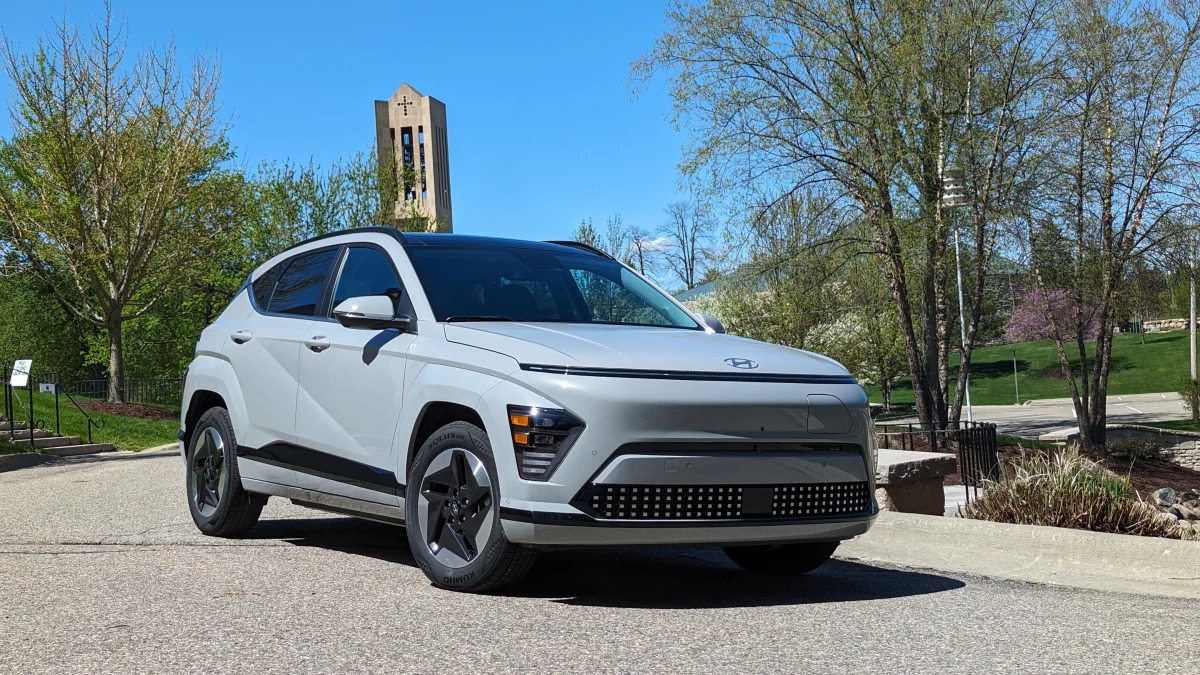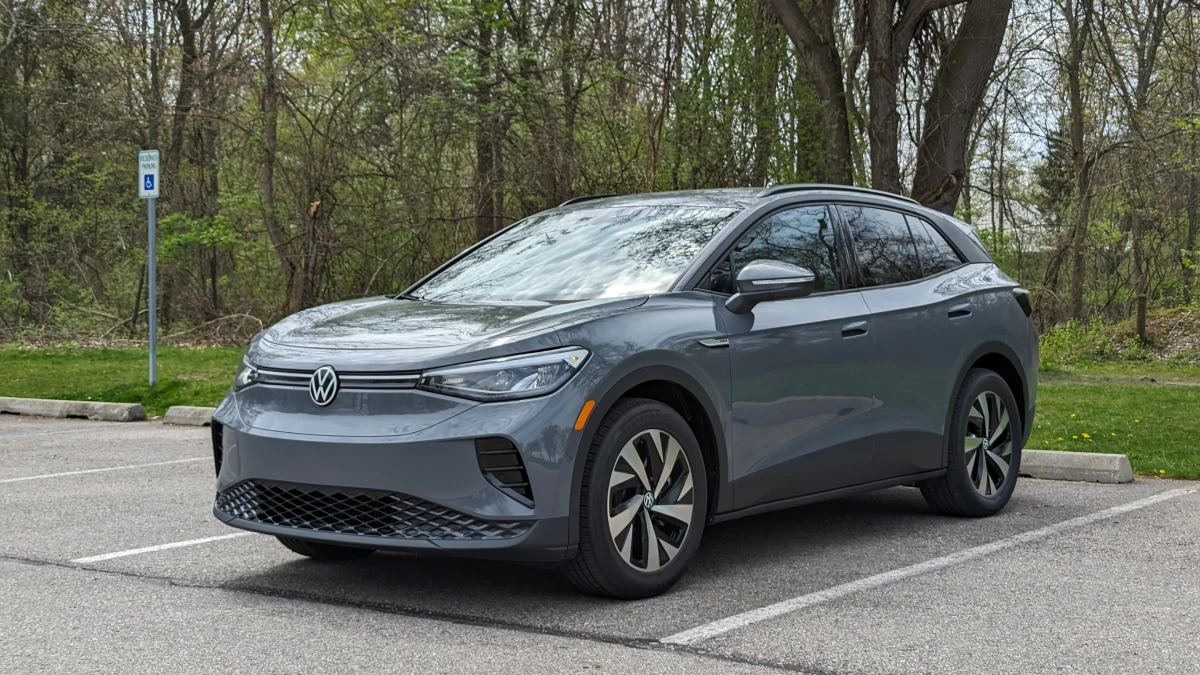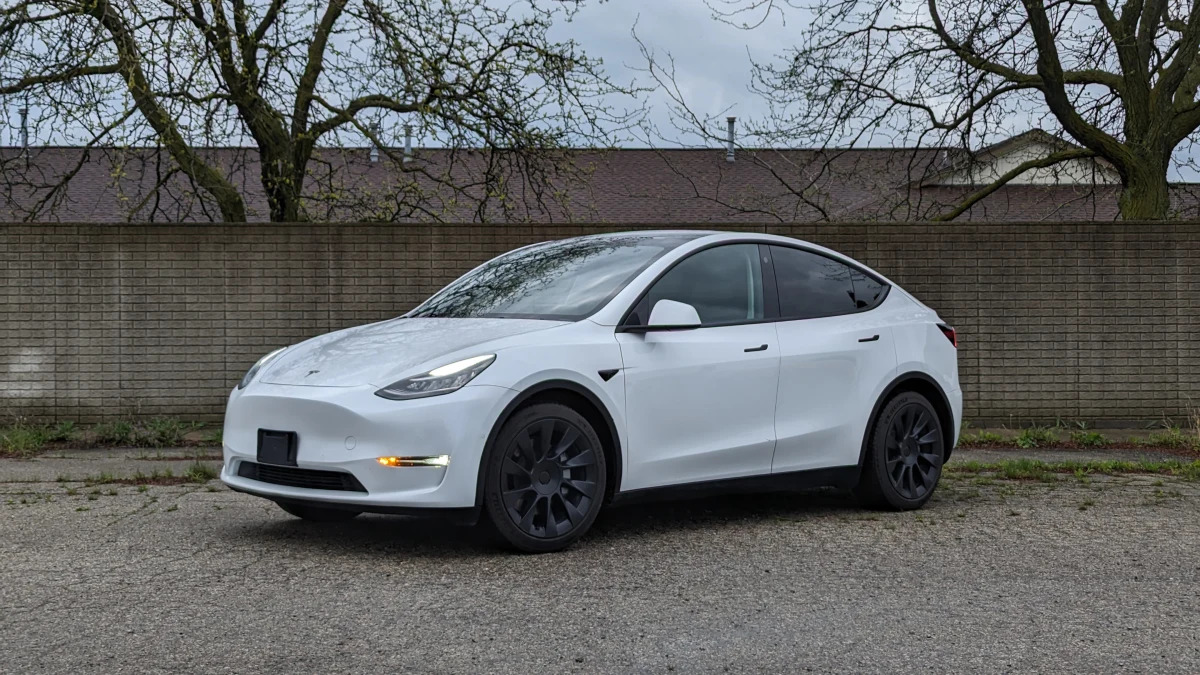EV Comparison Test: The best electric SUV for the average price of a new car in 2024

Going electric on a budget might sound like a far-fetched idea, but you can hop into a highly competent EV for a perfectly acceptable price in 2024. The average cost of a new car these days hovers between $45,000 and $50,000, or right around $10,000 more expensive than it was just five years ago. Does “average” also mean “affordable?” Your perspective may depend on whether your paycheck has swelled at the same rate as new car prices. This is the new normal regardless of the country’s ability to afford it, so we used the average price of a new car as a guide to pit several electric SUVs right smack dab in the middle of the car market against each other.
Entrants for comparing electric SUVs include the Tesla Model Y Long Range, Volkswagen ID.4 Pro, Hyundai Kona Electric Limited and Kia Niro EV Wave. We invited mainstays like the Ford Mustang Mach-E, Hyundai Ioniq 5 and Kia EV6 (and even the Nissan Ariya), but those automakers either declined to participate or elected to send alternative vehicles. Of course, the Tesla was a rental, but a necessary entry considering the SUV’s popularity – it was quite literally the best-selling vehicle in the world in 2023.
“The affordability of electric vehicles is a hot-button issue, as technology, value and even politics are intersecting in ways the car business seldom sees,” Editor-in-Chief Greg Migliore said. “With this test, we sought to analyze the merits of these vehicles through the lens of the consumer, while weighing their strengths and weaknesses against cost.”
With the field feeling a little lopsided in stature from the beginning, it became a question of which EV is the best value for around $45,000. While the low-trim and spartan Model Y and ID.4 had size on their side, both the Niro EV and Kona Electric came fully loaded with every goodie in the trick-or-treat bag. Other vitals like driving dynamics, charging speed, range and the charging network itself played into the scoring. In the end, two EVs shone the brightest, but there can only be one winner.
2024 Kia Niro EV Wave
Fourth place: Kia Niro EV Wave. $46,760; 155 points
Our very own Senior Editor James Riswick just so happens to own a Niro EV, but it fared the worst in this test. Like the Kona Electric, the Niro EV starts out life under a platform that supports multiple powertrain types — in the Niro’s case from a regular hybrid to a PHEV. Its lowlights are its charging performance, mediocre driving enjoyment, no federal tax credit and general lack of utility versus others in this test.
Personality-wise, the Niro EV wins big, though. Its slick aero blade scythes from top to bottom. The car-like height and hatchback utility give it an attractive stance with plenty of practicality. That said, the backseat and cargo space (while fine for some use cases) are undeniably tight compared to the ID.4 and Model Y. At least the tech interface is a roaring success, as most of us found the switchable toolbar center stack and dual widescreens sitting before us a great interface to use, minus the absent wireless Apple CarPlay/Android Auto.
Unfortunately for the Niro EV, we can’t overlook its sticking points in spite of its strengths. Fast-charging peaks at 85 kilowatts, which makes it a poor road trip vehicle. We saw no better than 77 kW when testing the Niro EV’s charging capability on Electrify America chargers, which is going to require some patience in the parking lot should you rely on public chargers.

Driving the Niro EV isn’t exactly a heart-pounding experience either, as it takes a second for its 188 pound-feet of torque to get those front wheels (no AWD option, another strike) turning before traction control reins them back in. It’s sorta fun to try and manage the silly torque steer, but Kia hasn’t designed the chassis to encourage any sort of enthusiastic driving.
“I was having a grand time scooting around in it until I was thoroughly embarrassed by a Toyota RAV4 Hybrid pulling away from a stoplight,” Associate Editor Byron Hurd noted. “These 2WD EVs are a lot like diesels; the torque makes them feel a lot quicker than they really are. And that’s the Kia in a nutshell – it feels like a lot more car than it really is, and that’s just not good enough in a segment becoming saturated with dedicated BEV models.”

2024 Hyundai Kona Electric Limited
Third place: Hyundai Kona Electric Limited. $42,420; 165 points
Most of what we said about the Niro EV also applies to the Kona Electric, but despite how similar these two are, the Kona is a shoo-in over the Niro. Having just been redesigned for 2024, it enjoys a much more coherent and feature-rich tech interface than the Niro. Its plethora of physical interior buttons are a big plus in our book, and the design simply brings more excitement to the table in terms of colors and textiles. Not to mention, it’s over $4,000 less than the Kia, and the Niro doesn’t do much to make up for its extra cost.
The Kona’s charging – 100 kW max speed – is also notably better than the Niro EV, though it’s hard to get very excited about that still-slow charging or even how the Kona Electric drives. Its soft chassis tuning makes for a comfy and forgiving ride, and while the previous generation Kona was known for its enthusiast-friendly handling, this one prioritizes plushness and size over all-out driving capability. This turn toward civility also means the Kona is a respectable size, hauling along a big enough back seat and an eminently usable cargo space for how small it is. That said, it’s no better than the Niro where utility is concerned and certainly takes a backseat to the ID.4 and Model Y.

To make up for a lack of space, all those features like ventilated seats, mega-huge screens and epic upholstery help the Kona stand out in ways it probably shouldn’t in this crowd. None of its pluses bring it near the top of the leaderboard, but the Kona is an EV that can work splendidly for many folks’ lifestyles.
“This is the EV I’d want to hop into for jaunts around the city, being able to dice it up in traffic, maneuver tight parking lots and narrow one-way streets, and fling around every corner I encounter,” Senior Editor, Electric, John Beltz Snyder writes. “I also appreciate the tech on hand — the infotainment system is user-friendly, and the safety systems work well without being annoying. It’s a shame about the rear-seat space (still a little tight for families) and slow charging rates, though.”

2024 Volkswagen ID.4 Pro
Second place: Volkswagen ID.4 Pro. $46,595 (w/tax credit $39,095); 177 points
The ID.4 Pro came a mere point away from stealing this comparo, and a couple of editors even voted for it to win. Its value proposition is spectacular since it’s able to take advantage of the point-of-purchase $7,500 tax credit. That leaves you with a family-friendly EV that can go 291 miles on a charge and get you back on the road in a semi-reasonable time on a road trip, and it still drives commendably well.
One important item to note for this ID.4 is that it’s the refreshed 2024 model with the new infotainment system and more powerful electric motor. Funnily enough, that infotainment system is still a weak point despite it being vastly improved compared to its predecessor. We’d suggest using the wireless Apple CarPlay/Android Auto as much as possible. The lack of amenities inside the ID.4 compared to the Niro and Kona are reflective of its price, and cost-savings in the form of dreary interior appointments and mediocre materials keep it from being aces across the board. Another interior snag on the ID.4 are its manual seats (no power at this trim level!) with its slide adjustment lever sticking far enough out from under the seat that it would often tangle with our ankles getting in and out.

The more powerful electric motor from its refresh makes the ID.4 the second-most exciting vehicle to drive in this test, though, as it scoots forward with enough verve to keep us entertained going straight. Of course, it’s nowhere near as exhilarating to drive as the Model Y, but a get-around-town SUV doesn’t necessarily need to be a 0-to-60 barnstormer. We enjoyed the forgiving ride on rougher roads, though its composure through corners had us scratching our heads a bit. The ID.4 drives around on its tippy-toes, a little unsure of itself before taking a more confident set. And man, those brakes are a real downer. There’s no one-pedal drive mode like every other car in this test, and the pedal feel is egregiously squishy and difficult to modulate. Just fixing a few of these driving snags might have been enough to tip the scales in the ID.4’s favor.
So why’s the ID.4 come home in second? Despite its downsides, the Volkswagen doesn’t suffer from the more debilitating compromises seen in the Niro EV and Kona Electric. It’s built on a dedicated EV platform and enjoys the benefits of such construction like a big 82 kWh battery pack with an impressive 175 kW max charge rate and a superior RWD layout. Plus, its spacious backseat and cargo area see it skyrocket ahead in utility scores. The near-win is really driven home when you see the price is under $40,000 thanks to its ability to qualify for the federal tax credit.
“It’s awesome to drive a single-motor EV that feels really gutsy, thanks to that punchier 285-horsepower rear unit,” News Editor Joel Stocksdale said. “And the whole car feels so light and tossable. With that light nose, too, it dives for corners unlike most crossovers of this size, electric or otherwise. I genuinely had fun driving it, and that goes a long way with me. I’ve come away from the ID.4 as a real defender for it.”

Tesla Model Y Long Range
First place: Tesla Model Y Long Range AWD. $52,630 (w/tax credit $45,130); 178 points
The Tesla wins by a hair. When you take a look around at what $45,000 can buy you in the world of EVs, there simply isn’t a more comprehensive package of range, performance, charging network, interior space and tech than what the Model Y offers.
Our tester was a 2021 model year rental in the Long Range AWD spec – today, that model is rated for 292 miles and does the 0-60-mph sprint in 4.8 seconds. It feels damn quick from behind the wheel, and its handling backs up the acceleration with excellent composure and balance at every turn. There’s zero doubt that the Model Y is the most fun-to-drive car in this comparison, from its sporty steering to the rapid response to every input, there’s plenty for an enthusiast to enjoy.
Its ride and general refinement are the exact opposite, as a crashy suspension over road heaves and general rattliness are off-putting on poor roads. Sure, our test car had over 40,000 miles on it, but that’s no excuse for a rear suspension booming and crashing over bumps as much as it did. That would get tiresome on a road trip, but, despite that, the Model Y is the best road trip vehicle in this group. The Tesla Supercharger network – while coming soon to other brands – is the single biggest advantage Tesla holds over the competition. It’s not just access to chargers either, but the ease with which you can locate them, pay and get back on the road again seamlessly. Plus, the Model Y charges fast at a peak of 250-kW, meaning your stops will be far quicker than most other EVs. During testing, the bank of Electrify America chargers were going in and out of service all day (something we see commonly when testing EVs), but there wasn’t a single hiccup over at the Superchargers we tried out.

The Model Y’s infotainment system drew a mixed bag of reactions. Many of us applauded its fluid and iPad-like functionality, but it’s a good thing the screen is as competent as it is because the lack of an instrument cluster or HUD is still a huge knock against the Tesla. There are shortcuts, gestures and more that you learn when you spend more time with the system that don’t necessarily present themselves at first glance. This can make first impressions rougher than most, but spend time learning what Tesla has designed, and you’re likely going to enjoy a lot of its tech. Most of us made our peace with the system, minus some grumbling about the absence of Apple CarPlay/Android Auto.
Lastly, it’s impossible to talk Tesla without mentioning Autopilot and Full-Self Driving (note that it’s a Level 2 system and not autonomous). Our test car was subscribed to FSD – $99 per month these days – and we tested it extensively. In many cases, like the highway, it’s a splendid stress reliever that you can largely rely on. But it will also steer you very wrong off the interstate in ways that are verging on uncomfortable to dangerous. Use it in the areas that Tesla has better ironed out at this point, though, and it becomes a huge positive for the Model Y over the others.
“Judged solely on specifications, the Model Y travels further and charges faster than anything else in its price range,” Consumer Editor Jeremy Korzeniewski wrote. “It’s also quick, full of technology, safe and reliable. As much as I may complain about its bland and bulbous styling, the lack of instrumentation in front of the driver and its oddly loud and boomy cabin — which, incidentally, isn’t an issue that plagues the Model 3 sedan — the overall Model Y package is just plain superior to its competition.”
For right around the average price of a new car today, the Model Y is the most EV you can buy. There are cheaper (and perhaps even better) options coming like the Chevrolet Equinox EV and Volvo EX30. And if we had entry-level versions of cars like the Ioniq 5 or EV6, the results may not add up the same, but, for today, the Model Y stands tall.
Related video:



